Leonardo Torres Quevedo
Leonardo Torres Quevedo (Spanish: [leoˈnaɾðo ˈtores keˈβeðo]; 28 December 1852 – 18 December 1936) was a Spanish civil engineer, mathematician and inventor. A prolific and versatile innovator, his fields of interest in engineering were very extensive and included mechanics, aeronautics, and automatics. One of his greatest achievements was El Ajedrecista (The Chess Player) of 1912,[3] an electromagnetic device capable of playing a limited form of chess that demonstrated the capability of machines to be programmed to follow specified rules (heuristics) and marked the beginnings of research into the development of artificial intelligence.[4]
Leonardo Torres Quevedo | |
|---|---|
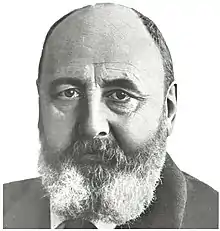 Torres in 1917 | |
| Born | Leonardo Torres Quevedo 28 December 1852 Molledo, Spain |
| Died | 18 December 1936 (aged 83) Madrid, Spain |
| Burial place | Saint Isidore Cemetery |
| Nationality | Spanish |
| Education | Official School of the Road Engineers' Corps of Madrid |
| Occupations | Inventor, mathematician, engineer, Esperantist |
| Years active | 1876–1930 |
| Known for | See list
|
| Notable work | Essays on Automatics (1914) |
| Spouse |
Luz Polanco y Navarro
(m. 1885) |
| Children | 8, including Gonzalo Torres Polanco |
| Awards | See list
|
| Engineering career | |
| Discipline | Civil engineering Mechanical engineering Aeronautics Electromechanics Computer science Robotics Naval architecture |
| Member of the Spanish Royal Academy of Sciences | |
| In office 19 May 1901 – 18 December 1936 | |
| Member of the Board for Expansion of Studies and Scientific Research | |
| In office 15 January 1907 – 18 December 1936 | |
| Corresponding Member of the Argentine Scientific Society | |
| In office 2 August 1910 – 18 December 1936 | |
| Seat N of the Royal Spanish Academy | |
| In office 31 October 1920 – 18 December 1936 | |
| Preceded by | Benito Pérez Galdós |
| Succeeded by | Manuel Machado |
| President of the Royal Spanish Mathematical Society | |
| In office 4 December 1920 – 2 February 1924 | |
| Preceded by | Zoel García de Galdeano |
| Succeeded by | Luis Octavio de Toledo y Zulueta |
| President of the Spanish Section of the International Committee for Weights and Measures | |
| In office 9 February 1921 – 20 June 1929 | |
| Honorary Member of the Geneva Society of Physics and Natural History | |
| In office 17 May 1923 – 18 December 1936 | |
| Corresponding Member of the Hispanic Society of America | |
| In office 12 December 1925 – 18 December 1936 | |
| Foreign Associate Member of the French Academy of Sciences | |
| In office 27 June 1927 – 18 December 1936 | |
| President of the Spanish Royal Academy of Sciences | |
| In office 2 February 1928 – 31 October 1934 | |
| Preceded by | José Rodríguez Carracido |
| Succeeded by | Blas Cabrera |
| Signature |  |
Torres' first major project was the patent for a new cable car system in 1887 to transport people safely, an area that culminated in 1916 with the Whirlpool Aero Car located in Niagara Falls, that carries 35 standing passengers over a one-kilometre trip.[5] He published Sur les machines algébriques (1895) and Machines á calculer (1901), works that gave him a notorious reputation in France, carrying out the construction of several analog machines for the resolution of algebraic equations.[6]
He made significant aeronautical contributions in the early 20th century, from a mooring post with a superior pivoting platform to be able to moor a dirigible outdoors, to the Astra-Torres airship, a trilobed cross section structure that began to be manufactured from 1911 and was widely used by the Allied Powers during World War I. Torres was also a key figure in the development of radio control in 1901 with the Telekine, which he created modern wireless remote-control operation principles.[7]
Torres' pioneering advances included the designs for a special-purpose electromechanical calculator in his 1914 paper Essays on Automatics, which has been qualified by British historian Brian Randell as "a fascinating work which well repays reading even today",[8] where he also proposed an early form of floating point values and automata with discernment capacity.[9] He successfully demonstrated the feasibility of an electromechanical analytical engine by producing a typewriter-controlled calculating machine in 1920.[10]
Between 1900 and 1930, he conceived other original designs, especially in naval engineering, such as the Camp-Vessel (a dirigible-carrying boat), and the Binave (a multihull steel ship). In addition to his technical work, Torres also stood out in the field of letters, and was a noted speaker and supporter of Esperanto.[11]
Early years
Torres was born on 28 December 1852, on the Feast of the Holy Innocents, in Santa Cruz de Iguña, Cantabria, Spain. His father, Luis Torres Vildósola y Urquijo, was a civil engineer in Bilbao, where he worked as a railway engineer. His mother was Valentina de Quevedo y Maza. The family resided for the most part in Bilbao, although they also spent long periods in his mother's family home in Cantabria's mountain region. During his childhood, he spent long periods of time separated from his parents due to work trips. Therefore, he was cared by a relatives of his father, the Barrenechea ladies, who declared him heir to their property, which facilitated his future independence.[12]
He studied high school in Bilbao and later went to Paris, to the College of the Christian Brothers, to complete studies for two years (1868 and 1869),[13] where he met French culture, customs, and language and that in later years it would help him in his scientific-technical relationships with personalities, and scientific institutions. In 1870, his father was transferred, bringing his family to Madrid. The following year, Torres began his higher studies in the Official School of the Road Engineers' Corps. He temporarily suspended his studies in 1873 to volunteer for the defense of Bilbao, which had been surrounded by Carlist troops during the Third Carlist War. Once the siege of Bilbao was lifted in 1874, he returned to Madrid and completed his studies in 1876, graduating fourth in his class.[14]
Career
Torres began to work as a civil engineer for a few months on railway projects as his father did, but his curiosity and desire to know and learn led him to give up joining the Corps to dedicate himself in "thinking about his things".[15] As a young entrepreneur who had inherited a considerable family fortune, he immediately set out on a long trip through Europe in 1877, visiting Italy, France and Switzerland, to know the scientific and technical advances of the day, especially in the incipient area of electricity.[16][14] Returning to Spain, he settled in Santander, where he continued his self-supported research activities.
Cableways
_-_Fondo_Car-Kutxa_Fototeka.jpg.webp)
Torres' experimentation in the field of cableways and cable cars began very early during his residence in the town of his birth, Molledo. There, in 1887, he constructed the first cableway to span a depression of some 40 metres (130 ft). The cableway was about 200 metres (660 ft) across and pulled by a pair of cows, with one log seat. This experiment was the basis for his first patent application in Spain, "Un sistema de camino funicular aéreo de alambres múltiples" ("A multi-wire suspended aerial system"),[17] for a cable car with which he obtained a level of safety suitable for the transport of people, not only cargo. The patent was later extended to other countries: United States, Austria, Germany, France, United Kingdom, and Italy.[18] Torres' cable cars used an innovative multi-cable support system, in which one end of a cable is anchored to fixed counterweights and the other (through a system of pulleys) to mobile counterweights. With this system the axial force of the cables via is constant and equal to the weight of the counterweight, regardless of the load in the shuttle. What will vary with this load is the deflection of the via cables, which will increase by raising the counterweight. Thus, the safety coefficient of these cables is perfectly known, and is independent of the shuttle load. The resulting design is very strong and remains safe in case of a support cable failure. Later, he constructed a cableway over the Río León in Valle de Iguña, Spain, that was faster and motorized, but still used solely for the transport of materials, not of people.[19][20][21]
In 1889 Torres presented his cableway in Switzerland,[22] a country very interested in that form of transport owing to its geography, and which was already starting to use cable cars for bulk transport in the Klimsenhorn-Pilatus Kulm line. However, he put his project on hold for a few years due to both rejection by Swiss engineers and comments and caricatures that appeared in the press of that country.[23] On 30 September 1907, Torres put into operation a pioneer cableway suitable for the public transportation of people in San Sebastián, the Mount Ulia aerial ropeway. The journey was 280 meters, with a drop of 28 meters, lasted for just over three minutes, and the gondola had the capacity to board up to 18 people on each trip. The execution of the project was the responsibility of the Society of Engineering Studies and Works of Bilbao.[24][25][26]

The positive results of this type of cable car led him to develop his most famous cable car, the Spanish Aerocar in Niagara Falls in Canada. The cableway of 550 meters in length is an aerial cable car that spans the whirlpool in the Niagara Gorge on the Canadian side. It travels at about 7.2 kilometres per hour (4.5 mph). The load per cable via is 9 tonnes (9.9 short tons), with a safety coefficient for the cables of 4.6.[27] It was constructed between 1914 and 1916. For its construction and assembly, the Niagara Spanish Aerocar Company Limited was set up from the Society of Engineering Studies and Works, both companies promoted by Torres, with a capital of $110,000 (roughly $3.2 million in 2022),[28] and a planned concession of 20 years. The construction was directed by Torres' son, Gonzalo Torres Polanco.[29] It completed its first successful tests on the 15th of February in 1916 and was officially inaugurated on the 8th of August, opening to the public the following day. The cableway, with small modifications, runs to this day with no accidents worthy of mention, constituting a popular tourist and cinematic attraction.[30] A plaque, mounted on a boulder in front of Aero Car Gift Shop recalls this fact: International Historic Civil Engineering Site. THE NIAGARA SPANISH AEROCAR. A tribute to the distinguished Spanish Engineer who designed the Niagara Spanish Aerocar. This was only one of his many outstanding contributions to the engineering profession. Engineer Leonardo Torres Quevedo (1852–1936). Constructed 1914–1916. CSCE. The Canadian Society for Civil Engineering. 2010. Asociación de Ingenieros de Caminos, Canales y Puertos de España. Spanish aerial ferry of the Niagara.[31]
Analogue calculating machines
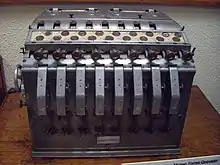
Since the middle of the 19th century, several mechanical devices were known, from integrators, multipliers, to the Analytical engine of Charles Babbage. The work of Torres in this matter is framed within this tradition, which began in 1893 with the presentation of the "Memória sobre las máquinas algébricas" ("Memory about algebraic machines") at the Spanish Royal Academy of Sciences in Madrid.[32] This paper was commented in a report by Eduardo Saavedra in 1894 and published in the Revista de Obras Públicas.[33] Torres developed a first model of the machine, and Saavedra recommended that the final project of the device be financed.[34] Torres' calculating machine was considered in its time as an extraordinary event in the course of Spanish scientific production. In 1895 he presented "Machines algébriques", accompanied by his demonstration model, at the Bordeaux Congress of the Association pour l'Avancement des Sciences, and in Paris in the Comptes rendus de l'Académie des Sciences.[35] Later on, in 1900, he presented a more detailed work, "Machines á calculer" ("Calculating machines") at the Paris Academy of Sciences. The commission, informed favorably by Marcel Deprez, Henri Poincaré and Paul Appell, asked the academy for its publication,[36][37] highlighting: "... Mr. Torres has given a theoretical, general and complete solution to the problem of the construction of algebraic and transcendental relations by means of machines..."[38]
These machines examined mathematical and physical analogies that underlay analogue calculation or continuous quantities, and how to establish mechanically the relationships between them, expressed in mathematical formulae. The study included complex variables and used the logarithmic scale. From a practical standpoint, it showed that mechanisms such as turning disks could be used endlessly with precision, so that changes in variables were limited in both directions.[39][40][41] On the practical side, Torres built a whole series of analogue calculating machines, all mechanical. These machines used certain elements known as arithmophores which consisted of a moving part and an index that made it possible to read the quantity according to the position shown thereon.[42] The aforesaid moving part was a graduated disk or a drum turning on an axis. The angular movements were proportional to the logarithms of the magnitudes to be represented. Between 1910 and 1920, using a number of such elements, Torres developed a machine that was able to compute the roots of arbitrary polynomials of order eight, including the complex ones, with a precision down to thousandths. The machine calculated the following formula: where X is the variable and A1 ... A8 is the coefficient of each term. Considering the case of α = 1, it becomes the following formula, and the root of the algebraic equation can be obtained:
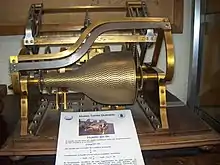
By calculated each term on a logarithmic scale, they can be calculated only by sums and products like A1 + a × log(X), which can handle a very wide range of values, and the relative error during calculation is constant regardless of the size of the value. However, in order to calculate the sum of each term, it is necessary to accurately obtain log(u + v) from the calculated values log(u) and log(v) on a logarithmic scale. For this calculation, Torres invented a mechanism called "endless spindle" ("fusee sans fin"), a complex differential gear with a helical gear, which allowed the mechanical expression of the relation . Putting log(u) - log(v) = log(u/v) = V, and using u/v = 10 V, calculate log(u + v) using the following formula: ,[43] the same technique which is the basis of the modern electronic logarithmic number system.
In addition to this machine, Torres devised other with a small computing using gears and linkages around 1900 to obtain the complex number solution of the quadratic equation X2 - pX + q = 0.[44] The machines are kept in the Torres Quevedo Museum at the School of Civil Engineering of the Technical University of Madrid.[45]
Aerostatics
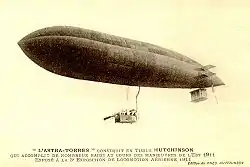
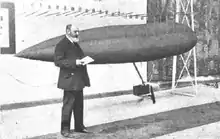
In 1902, Torres started the project of a new type of dirigible that would solve the serious problem of suspending the gondola, applying for a patent in France for ‘Perfectionnements aux aerostats dirigibles’ ("Improvements in dirigible aerostats"),[46][47] complemented, with a "Note sur le calcul d’un ballon dirigeable a quille et suspentes interieures" ("Note on the calculus of a dirigible balloon with interior suspension and keel") which was presented together to Madrid and Paris’ Academies of Science.[48][49] Opposite to the usual cylindrical envelope, and with the objective of minimizing its stress and subsequent permeability, Torres conceived a trilobed envelope with three longitudinal cables (ropes) placed in the intersection of every two lobes. Inside the envelope, and on the basis of those three cables, a longitudinal frame of triangular cross section was to be completed, made up of non-rigid ropes, permeable fabric curtains, metal cables and longerons. Longitudinal cables and frame would ‘rigidify’ altogether through the excess of pressure level of the gas, so that, when inflated, it would act as an internal rigid structure. A system known as "auto-rigid".[50] By the end of that year the report at Paris's Academy of Science was included in the French journal L’Aerophile, and a summary in English was published in the British The Aeronautical Journal.[51][52]
In 1904, Torres was appointed director of the Centre for Aeronautical Research in Madrid, "for the technical and experimental study of the air navigation problem and the management of remote engine maneuvers".[53]
In 1905, with the help of Alfredo Kindelán, he directed the construction of the first Spanish dirigible in the Army Military Aerostatics Service, located in Guadalajara. Once the construction was successfully completed in 1908, the new airship, which received the name of Torres Quevedo, carried out several test flights. As a result, a collaboration began between Torres and the Société Astra led by the French engineer Édouard Surcouf, which managed to buy the patent with a cession of rights extended to all countries except Spain, in order to make possible the construction of the dirigible in its country. So, in 1911, the construction of dirigibles known as the Astra-Torres airships was begun and Torres would receive royalties of 3 francs for every m³ of each airship sold.[54]

To find a resolution to the slew of problems faced by airship engineers in docking dirigibles, Torres also drew up designs for a ‘docking station’ and made alterations to airship design. In 1910, Torres proposed the idea of attaching an airship's nose to a mooring mast and allowing the airship to weathervane with changes of wind direction. The use of a metal column erected on the ground, the top of which the bow or stem would be directly attached to (by a cable) would allow a dirigible to be moored at any time, in the open, regardless of wind speeds. Additionally, Torres' design called for the improvement and accessibility of temporary landing sites, where airships were to be moored for the purpose of disembarkation of passengers. The final patent was presented in February 1911 in Belgium, and later to France and the United Kingdom in 1912, under the title "Improvements in Mooring Arrengements for Airships".[55][56][57]
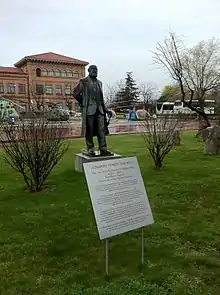
In Issy-les-Moulineaux (south-west of Paris) in February 1911, the trials of ‘Astra-Torres no.1’ were successful and had a capacity of 1600m³. It was faster, more stable and more manoeuvrable than all the systems before it. It won the ‘Deperdussin’ prize and the French army incorporated it into their operations. In 1913, the handing over of the Astra-Torres XIV (the HMA.No 3 to the Royal Naval Air Service) meant international recognition for the system with this ship beating the world speed record for an airship registering 83.2 km/h during the reception trials, a speed which reached 124 km/h with the wind in its favour. Other Astra-Torres dirigibles followed, including the Pilâtre de Rozier (Astra-Torres XV) named after the aerostier Jean-François Pilâtre de Rozier, which at 23,000 m3 was the same size of the German ‘Zeppelins’ and could reach speeds of around 100 km/h. The distinctive trilobed design was widely used during the First World War (1914–1918) by the Entente powers for diverse tasks, principally convoy protection and anti-submarine warfare.[58][59] This type of envelope was employed in the United Kingdom in the Coastal, C Star, and North Sea airships.[60]
In 1919, Torres designed, based on a proposal of the engineer Emilio Herrera Linares, a transatlantic dirigible, which was named Hispania,[61] aiming to claim the honor of the first transatlantic flight for Spain. Owing to financial problems, the project was delayed and it was the Britons John Alcock and Arthur Brown who crossed the Atlantic non-stop from Newfoundland to Ireland in a Vickers Vimy twin-engine plane, in sixteen hours and twelve minutes.[62][63]
The success of the trilobed blimps during the war even drew the attention of the Imperial Japanese Navy, who acquired the Nieuport AT-2 in 1922, with almost 263 ft long, maximum diameter 54 ft and with a hydrogen capacity of 363,950 ft 3.[64] After Torres' patent expired that year, many airships continued to be built with ideas inherited from this non-rigid design.[65]
Radio control: the Telekino
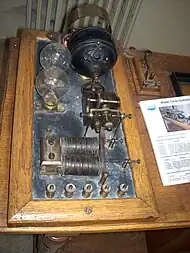
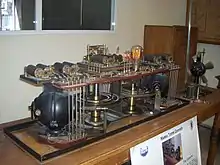
Torres was a pioneer in the field of remote control. He began to develop a new system around 1901 or 1902, as a way of testing his airships without risking human lives. For its device, he chose the name Telekino as a combination of two Greek words: tele which means "at distance" and kino which means "movement", resulting both together "movement at distance", which was what Torres wanted to obtain. Between 1902 and 1903, the invention titled "Systéme dit Télékine pour commander à distance un mouvement mécanique" ("Means or method for directing mechanical movements at or from a distance") applied for patents in France,[66] Spain,[67] and Great Britain.[68] On 3 August 1903, he presented the Telekino at the Paris Academy of Science, together with a detailed memory and a practical demonstration to its members,[69] For the construction of this initial prototype, Torres received help from Gabriel Koenigs, director of the Mechanics Laboratory of the Sorbonne, and Octave Rochefort, who collaborated by providing wireless telegraphy devices.[70]
The Telekino has three different parts: a wireless telegraph receiver, a multi-position rotary switch and two servomotors that can be used to drive a mechanical system. The signal transmitted by electromagnetic waves, is received by the antenna and is transformed into electric pulses by a coherer. Each pulse drives an electromagnet, which closes its secondary circuit causing the multi-position switch unit to go one step forward. This operation is repeated automatically as many times as the number of signal impulses. When the multi-position switch reaches its final position, the battery supplies current to the chosen servomotor terminal. Then, the servomotor is put in motion causing a known and previously defined action. Torres realized that in order to achieve a finite but not limited set of actions based on a binary system as the telegraph was, (with only two states, on and off), it was necessary to create a limited number of codewords through a sequence of binary states. The problem, at that time, was the impossibility of having a synchronisation mechanism able to detect the end of one character and the beginning of the next. In this situation, the only way to solve this difficulty was using an asynchronous synchronisation method based on the change in the telegraph signal state. The final proposal was as simple as using a code based on the number of pulses consecutively sent; so, the action, e.g. number 1, corresponded to one pulse, to two pulses corresponded the action number 2, to three pulses the action number 3 and so on.[71] Torres was able to select different positions for the steering engine and different velocities for the propelling engine independently. He was also able to act over other mechanisms such a light, for switching it or not, and a flag, for raising or dropping it, at the same time. Specifically, Torres was able to do up to 19 different actions with his prototypes.[72]
From 1904 Torres chose to conduct initial Telekino testings, first in an electric three-wheeled land vehicle[73] in the Beti Jai fronton of Madrid, with an effective range of just 20 to 30 meters, which has been considered the first known example of a radio-controlled unmanned ground vehicle (UGV).[69] The Spanish engineer José Echegaray described the Telekino as the origin of Torres' automatics. For Echegaray, "nobody moves" the Telekino. "It moves automatically", it is an automaton of "a certain intelligence, not conscious, but disciplined". He defined it as "a material apparatus, without intelligence, interpreting, as if it were intelligent, the instructions that are communicated to it."[74][75] In 1905, Torres tested a second model of the Telekino located in a boat in the pond of the Casa de Campo in Madrid, achieving distances of up to about 250 m. From the terrace of the Club Marítimo del Abra, and with the assistance of the president of the Provincial Council and other authorities, an experiment was carried out with the Telekino remotely controlling the maneuvers of the electrically powered launch Vizcaya.[76] On 25 September 1906, in the presence of the king Alfonso XIII and before a great crowd, he successfully demonstrated the invention in the port of Bilbao, guiding the launch Vizcaya from the shore with people on board, demonstrating a standoff range of 2 km.[77] The positive results of those experiences encouraged Torres to apply to the Spanish government for the financial aid required to use his Telekino to steer submarine torpedoes, a technological field which was just starting out. His application was denied, which caused him to abandon the development of the Telekino.[78]
Formal language
In 1907, Torres introduced a formal language for the description of mechanical drawings, and thus for mechanical devices, in Vienna. He previously published "Sobre un sistema de notaciones y símbolos destinados a facilitar la descripción de las máquinas" ("System of notations and symbols intended to facilitate the description of the machines") in the Revista de Obras Públicas.[79] According to the Austrian computer pioneer Heinz Zemanek, this was equivalent to a programming language for the numerical control of machine tools.[80] He defined a table of symbols, a collection of rules and, as usual in his works, applied them to an example. This symbolic language reveals Torres' main capacities, both his ability to detect a problem, in this case a social problem of origin and its technical consequences, as well as his capacity for creation – invention – to give a rational, properly technical response. As Torres said: "Babbage and Franz Reuleaux – and I suppose others as well, although I don't have news of them – have tried, without any success, to put remedy to this inconvenience; but although these eminent authors have failed, should not be a sufficient reason to abandon such an important effort".[81]
Laboratory of Automation
As a member of the steering committee of the Board for Expansion of Studies and Scientific Research (Junta para Ampliación de Estudios e Investigaciones Científicas) established in 1907 to promote research and scientific education in Spain,[82] Torres played a leading and decisive role in the creation of three keys state agencies to understand the impulse that institution gave to experimentation, both in the field of education and in research, regardless of the discipline: the Laboratory of Automation (1907) — of which he was named director,[83] the construction of instruments – the Laboratories Association (1910) – the union of state laboratories and workshops – and the Institute of Science Materials (1911) – the budget allocation. He not only built his own inventions, but also provided services and support to universities and researchers of the Board. The Laboratory of Automation produced the most varied instruments, such as the spectrographic equipment of Ángel del Campo and Miguel A. Catalán, the interferometer of Manuel Martínez Risco, the stalagmometer of Juan Negrín, the microtome of Santiago Ramón y Cajal and the X-ray spectrometer of Blas Cabrera, among others.[84][85]
Chess automaton: El Ajedrecista
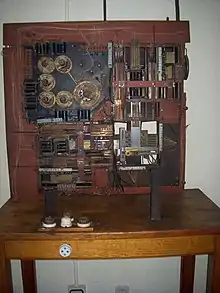
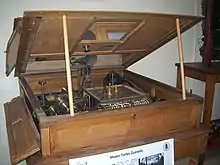
In early 1910, Torres began to construct a chess automaton he dubbed El Ajedrecista (The Chess Player). As opposed to The Turk and Ajeeb, El Ajedrecista had a true integrated automation and could automatically play a king and rook endgame against the king from any position, without any human intervention[86]
The pieces had a metallic mesh at their base, which closed an electric circuit that encoded their position in the board. When the black king was moved by hand, an algorithm calculated and performed the next best move for the white player.[87] The automaton does not deliver checkmate in the minimum number of moves, nor always within the 50 moves allotted by the fifty-move rule, because of the simple algorithm that calculates the moves. It did, however, checkmate the opponent every time.[88] If an illegal move was made by the opposite player, the automaton would signal it by turning on a light. If the opposing player made three illegal moves, the automaton would stop playing. The device has been considered the first computer game in history.[89]
It created great excitement when it made its debut, at the University of Paris in 1914.[90] Its internal construction was published by H. Vigneron in the French magazine La Nature.[91][92] It was widely mentioned in a Scientific American supplement as "Torres and His Remarkable Automatic Devices. He Would Substitute Machinery for the Human Mind", on November 6, 1915.[93][94]
An example game where White checkmates the black King, following Torres' algorithm. Recorded in Portable Game Notation:
[FEN "8/8/1k6/8/R7/8/5K2/8 w - - 0 1"] 1. Rh4 Kc5 2. Kf3 Kd5 3. Ke3 Kd6 4. Rh5 Kc6 5. Ke4 Kd6 6. Rg5 Kc6 7. Kd4 Kd6 8. Rg6+ Kd7 9. Kd5 Ke7 10. Rh6 Kf7 11. Ra6 Ke7 12. Rb6 Kf7 13. Ke5 Ke7 14. Rb7+ Kd8 15. Ke6 Kc8 16. Rh7 Kb8 17. Rg7 Ka8 18. Kd6 Kb8 19. Kc6 Ka8 20. Kb6 Kb8 21. Rg8#

A second version was constructed under the supervision of his son Gonzalo, and was presented in Paris in 1922. It was more elegant and technically perfected. The mechanical arms to move pieces were replaced for electromagnets located under the board.[95] It also included a sound effect, with a voice recording announcing checkmate when the computer won the game.[96]
The advanced machine was introduced to a greater audience at the 1951 Paris Cybernetic Congress and explained to Norbert Wiener.[97] El Ajedrecista also defeated Savielly Tartakower at the Congress, being the first Grandmaster to lose against a machine.[98] Heinz Zemanek played against this chess machine at the Brussels World Fair in 1958, described it as "a historical witness of automaton artistry that was far ahead of its time". According to Zemanek, Torres designed a very clever six-part algorithm for the end game, which was implemented using levers, gears, and relays.[99]
Essays on Automatics
It has been commonly assumed (see Metropolis and Worlton 1980) that Charles Babbage’s work on a mechanical digital program-controlled computer, which he started in 1835 and pursued off and on until his death in 1871, had been completely forgotten and was only belatedly recognized as a forerunner to the modern digital computer. Ludgate, Torres y Quevedo, and Bush give the lie to this belief, and all made fascinating contributions that deserve to be better known.
— Brian Randell, presentation at MIT (1980), printed in Annals of the History of Computing, IEEE (October 1982)[100]

In 1914, Torres published his most outstanding work, "Ensayos sobre Automática. Su definición. Extensión teórica de sus aplicaciones" ("Essays on Automatics. Its Definition – Theoretical Extent of Its Applications"), in which he took up the subject of what he called Automatics, "another type of automaton of great interest: those that imitate, not the simple gestures, but the thoughtful actions of a man, and which can sometimes replace him". Torres drew a distinction between the simpler sort of automaton, which has invariable mechanical relationships and the more complicated, interesting kind, whose relationships between operating parts alter "suddenly when necessary circumstances arise". Such an automaton must have sense organs, that is, "thermometers, magnetic compasses, dynamometers, manometers", and limbs, as Torres called them, mechanisms capable of executing the instructions that would come from the sense organs. The automaton postulated by Torres would be able to make decisions so long as "the rules the automaton must follow are known precisely".[101][102]
The paper provides the main link between Torres and Babbage. He gives a brief history of Babbage's efforts at constructing a mechanical Difference Engine and Analytical Engine. He described the Analytical Engine as exemplifying his theories as to the potential power of machines, and takes the problem of designing such an engine as a challenge to his skills as an inventor of electromechanical devices. The paper contains a complete design (albeit one that Torres regarded as theoretical rather than practical) for a machine capable of calculating completely automatically the value of the formula , for a sequence of sets of values of the variables involved. It demonstrates cunning electromechanical gadgets for storing decimal digits, for performing arithmetic operations using built-in function tables, and for comparing the values of two quantities. The whole machine was to be controlled from a read-only program (complete with provisions for conditional branching), represented by a pattern of conducting areas mounted around the surface of a rotating cylinder.[100]
The paper also introduced the idea of floating-point arithmetic, which historian Randell says was described "almost casually",[100] apparently without recognizing the significance of the discovery. He did it the way following:
"Very large numbers are as embarrassing in mechanical calculations as in usual calculations (Babbage planned 50 wheels to represent each variable, and even then they would not be sufficient if one does not have recourse to the means that I will indicate later, or to another analogue). In these, they are usually avoided by representing each quantity by a small number of significant figures (six to eight at the most, except in exceptional cases) and by indicating by a comma or zeros, if necessary, the order of magnitude of the units represented by each digit.
Sometimes also, so as not to have to write a lot of zeros, we write the quantities in the form n x 10.
We could greatly simplify this writing by arbitrarily establishing these three simple rules:
I. n will always have the same number of digits (six for example).
II. The first digit of n will be of order of tenths, the second of hundredths, etc.
III. One will write each quantity in the form: n; m.
Thus, instead of 2435.27 and 0.00000341682, they will be respectively, 243527 ; 4 and 341862 ; −5.
I have not indicated a limit for the value of the exponent, but it is obvious that, in all the usual calculations, it will be less than one hundred, so that, in this system, one will write all the quantities which intervene in calculations with eight or ten digits only."[103][104] The format that Torres proposed shows the need for a fixed-sized significand as is presently used for floating-point data.[105]
The paper ends with a comparison of the advantages of electromechanical devices that were all that were available to Babbage. It establishes that Torres would have been quite capable of building a general-purpose electromechanical computer more than 20 years ahead of its time, had the practical need, motivation, and financing been present.[106]
Analytical machines
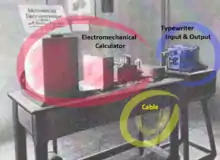
Torres went ahead to prove his theories with a series of working prototypes. He demonstrated twice, in 1914 and in 1920, that all of the cogwheel mechanisms of a calculating machine like that of Babbage could be implemented using electromechanical parts. His 1914 analytical machine used a small memory built with electromagnets, capable of evaluating p × q – b.[100]
In 1920, to celebrate the 100th anniversary of the invention of the arithmometer, he presented at a Paris conference the "Arithmomètre Electroméchanique" ("Electromechanical Arithmometer"), which consisted of an arithmetic unit connected to a (possibly remote) typewriter, on which commands could be typed and the results printed automatically[100] (e.g. "532 × 257" and "= " from the typewriter). This calculator was not programmable, but was able to print the numerical value of the answer.[107] From the user interface point of view, this machine can be regarded as the predecessor of current computers that use a keyboard as an input interface. In terms of usage, remote calculation by extension of electric wires is also assumed,[108] and it is considered to be a rudimentary system such as the current online system that uses communication lines. Torres had no thought of making such a machine commercially, viewing it instead as a means of demonstrating his ideas and techniques.[109] Furthermore, in a 1920 paper on electromechanical arithmometers,[110] he pointed out the need to represent continuous numbers as finite discrete values for processing and judgment in several automatic machines,[111] which corresponds to current digital processing.
Patents in other areas and naval projects
.jpg.webp)
In addition to the aforementioned inventions, Torres patented, among others, the "Coordinate Indicator" (1901) for guiding people for cities by a mechanical system of signals, which he proposed for Madrid and Paris under the name of "Guide Torres",[112][113] the "Dianemologo" (1907), a machine to copy, without the need to resort to shorthand, any speech to as it is pronounced,[114] "Deformable Fusiform Balloons" (1914),[115] and "Railway Interlocks T.Q." (1918), an interlock of his own design to protect the movement of trains within a certain area.[116][117]
On 30 July 1913, he designed the "Buque-Campamento" ("Camp-Vessel"),[118] a dirigible balloon carrier with a mooring mast and a hold large enough to house up to two inflated units, and hydrogen cylinders. Torres had thought of the possibility of combining aeronautics with the navy in this way, offering his patent to Vickers Limited, although the latter did not show any interest in the project.[119] In 1916 Torres patented in Spain a new type of catamaran which was conceived as a steel multihull vessel, receiving the name of "Binave" (Twin Ship).[120] He applied for the patent in the United Kingdom with the title "Improvements in Ships" in 1917,[121] and it was built in Bilbao in 1918, where it carried out its first tests. He introduced important innovations in this design, such as two 30 HP Hispano-Suiza marine engines, or the ability to modify its configuration when sailing, positioning two rudders at the stern of each float, and placing the propellers aft too.[122][123]
Educational inventions
In the last years of his life, Torres turned his attention to the field of educational disciplines, to investigate those elements or machines that could help educators in their task. From 1922 to 1930 he patented improvements on typewriters,[124] marginal pagination of manuals,[125] and, especially, the "Puntero Proyectable" ("Projectable Pointer"),[126] and the "Proyector Didáctico" ("Didactic Projector").[127] The Projectable Pointer was based on the shadow produced by an opaque body that moves close to the projected plate, being this shadow used as a pointer. To do this, he designed an articulated system that allowed the speaker to move a point or points next to the projection plate, at will, which made it possible to mark the areas of interest on the transparency.[128] The Didactic Projector improved the way slides were placed on glass plates for projection.[129]
Other activities

In 1910 Torres traveled to Argentina[130] with the Infanta Isabel to assist at the International Scientific Congress held in Buenos Aires, one of the events organized to mark the centenary of the independence of Argentina. He presented the project entitled "Unión Internacional Hispano–Americana de Bibliografía y Tecnología Científica", to clarify, enhance, unify, and enrich the Spanish technical language. The first task was the publication of a technological dictionary of the Spanish language in order to tackle the problems caused by the increasing use of scientific and technological neologisms, as well as the adaptation of words from other languages, confronted with the avalanche of foreign terms.[131] In 1930 appeared the Volume 1 of the Diccionario Tecnológico Hispanoamericano (Hispanic American Technological Dictionary).[132][133]
Esperantist
In the early 1900s, Torres learned the international language Esperanto, and was an advocate of the language throughout his life. From 1922 to 1926, he participated in the work of the International Committee on Intellectual Cooperation of the League of Nations,[134] proposing the following motion on the first day of the meeting: "The Committee, convinced of the usefulness of an artificial auxiliary language to facilitate scientific relations between different peoples, establishes a subcommittee in charge of studying , with the help of experts, the various solutions that have been proposed". Although almost half of the Committee members were in favor of Esperanto, the motion met with determined opposition from some other participants. In 1925 Torres participated as the official representative of the Spanish government in the "Conference on the Use of Esperanto in Pure and Applied Sciences" held in Paris, together with Vicente Inglada Ors and Emilio Herrera Linares. That same year, he joined to the Honorary Committee of the Spanish Association of Esperanto (HEA), founded by Julio Mangada.[135][136]
Distinctions
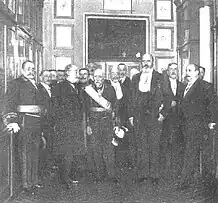
From the work he carried out in these years, Torres entered the Spanish Royal Academy of Sciences of Madrid in 1901, of which entity he was president between 1928 and 1934. In 1910 he became a corresponding member of the Argentine Scientific Society. In 1916 King Alfonso XIII of Spain bestowed the Echegaray Medal upon him;[137] and in 1918, he declined the offer of the position of Minister of Development. In 1920, he was admitted to the Royal Spanish Academy, to fill the seat vacated by the death of Benito Pérez Galdós, declaring modestly in his speech: "You were wrong in choosing me as I do not have that minimum culture required of an academic. I will always be a stranger in your wise and learned society. I come from very remote lands. I have not cultivated literature, nor art, nor philosophy, nor even science, at least in its higher degrees… My work is much more modest. I spend my busy life solving practical mechanics problems. My laboratory is a locksmith shop, more complete, better assembled than those usually known by that name; but destined, like all, to project and build mechanisms…" [138][139]
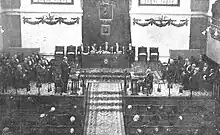
That same year he was elected president of the Royal Spanish Mathematical Society, a position he held until 1924 and became a member of the Department of Mechanics of the Paris Academy. From 1921 to 1929 he assumed the presidency of the Spanish section of the International Committee for Weights and Measures. In 1923 the Sorbonne named him an Honorary Doctor[140] and became an honorary member of the Geneva Society of Physics and Natural History. In 1925 was appointed a corresponding member of the Hispanic Society of America. In 1927 he was named one of the twelve foreign associate members of the French Academy of Sciences. Between 1906 and 1934 he also received other decorations:[141][142]
- Grand Cross of the Civil Order of Alfonso XII (1906)
- Parville Award by the French Academy of Sciences (1916)
- Grand Cross of the Order of Charles III (1921)
- Grand Cross of the Military Order of Saint James of the Sword (1921)
- Commander of the Legion of Honour (1922)
- Honorary doctorate by the University of Coimbra (1925)
- Grand-Cross Band of the Order of the Spanish Republic (1934)
Personal life and death
In 1885 Torres married Luz Polanco y Navarro in Portolín (Molledo), with whom he had eight children: Leonardo (died at age 2), Gonzalo (later his collaborator), Luz, Valentina, Luisa, Julia, Leonardo and Fernando. After the death of his first son, in 1889, he moved to Madrid with the firm intention of putting into practice the projects he had devised in previous years. During this time he attended the Athenæum, the literary gatherings at the Café Suizo and the Elipa, but generally without participating in debates and discussions of a political nature. He lived for many years in Calle de Válgame Dios nº 3.[143][144]
On 18 December 1936, after a progressive illness, Torres died at the home of his son Gonzalo in Madrid, in the heat of the Spanish Civil War, ten days before his eighty-fourth birthday.[145][146] He was buried in the monumental Saint Isidore Cemetery.[147]
Legacy and honours
The wise Spanish engineer Torres Quevedo - today a foreign associate of our Academy of Sciences - who is perhaps the most prodigious inventor of our time, at least in terms of mechanisms, has not afraid to tackle Babbage's problem in turn.
What prospects do such marvels open on the possibilities of the future as regards the reduction to a purely mechanical process of any operation obeying mathematical rules!" In this field, the way was opened, nearly three centuries ago, by the genius of Pascal; in recent times, the genius of Torres Quevedo has succeeded in making it penetrate into regions where one would never have dared to think a priori that it could have access.
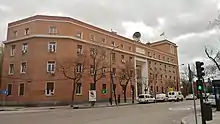
After Torres died in 1936, the distressing circumstances that Spain was going during its Civil War meant that his death would go somewhat unnoticed. However, such newspapers as The New York Times or the French mathematician Maurice d'Ocagne published obituaries in 1937 and 1938 praising his engineering and research work, the latter giving some conferences in Paris and Brussels.[149][150][151][152]
Created the Spanish National Research Council (CSIC) in 1939, the architect Ricardo Fernández Vallespín was commissioned with the project and construction of a large building in Madrid to house the new Institute «Leonardo Torres Quevedo» of Applied Physics, which was completed in 1943.[153][154] Its dedicated to "designing and manufacturing instruments and investigating mechanical, electrical and electronic problems", and was the germ of the current Institute of Physical and Information Technologies "Leonardo Torres Quevedo" (ITEFI).[155]
In the years following his death, Torres was not forgotten. In 1953 began the commemorative acts of the Centenary of his birth,[156] taking place at the Spanish Royal Academy of Sciences with the intervention of high-ranking academic, scientific and university personalities from the country and abroad, such as Louis Couffignal, Charles Lambert Manneback, and Aldo Ghizzetti.[157][158]
In 1955 and 1983, two postage stamps were issued in Spain in his honor, the last one next to the image of the Niagara cable car.[159]
The Leonardo Torres Quevedo Foundation (FLTQ) was created in 1981 under his name as a non-profit organization to promote scientific research within the framework of the University of Cantabria and to training professionals in this area. The Foundation had its headquarters at the University of Cantabria School of Civil Engineering.[160]
In 1983, the Leonardo Torres Quevedo National Research Award was established in Spain by the Ministry of Science to recognize the merits of Spanish scientists or researchers in the field of engineering.[161]
A bronze statue on a stone pedestal was erected in 1986 on the occasion of the fiftieth anniversary of his death. The work was commissioned to the sculptor Ramón Muriedas and its located in Santa Cruz de Iguña, Torres' birth town.[162]
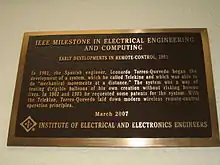
In 2007, the prestigious Institute of Electrical and Electronics Engineers (IEEE) dedicated a Milestone in Electrical Engineering and Computing[163] to the Telekino, based on the research work developed at Technical University of Madrid by Prof. Antonio Pérez Yuste, who was the driving force behind the Milestone nomination.
On 19 July 2008, Spain's National Lottery commemorated the centenary of the Torres Quevedo airship built in Guadalajara, which was the beginnings of the Spanish Military Aerostation.[164] The same year, the Leonardo Torres Quevedo Center was opened in Santa Cruz de Iguña, dedicated to his life and work.[165]
On 28 December 2012, Google celebrated his 160th birthday with a Google Doodle.[166] That same year the company had also commemorated the 100th anniversary of "El Ajedrecista", highlighting that it was a marvel of its time and could be considered the "grandfather" of current video games. A conference was organized on November 7 in cooperation with the School of Telecommunication Engineering of the Technical University of Madrid to exhibit the devices devised by the Spanish engineer.[167]
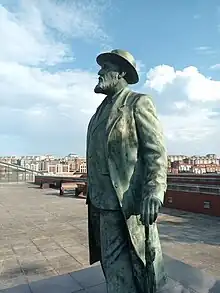
On 8 August 2016, the 100th Anniversary of the Whirlpool Aero Car was celebrated for its uninterrupted operation, without having had any accidents. The ceremony also included members of the Torres Quevedo family, who made a special trip from Spain to attend the anniversary celebrations and Carlos Gómez-Múgica , the Spanish Ambassador to Canada. According to Niagara Parks Commission Chair, Janice Thomson, "this morning’s celebrations have allowed us to properly mark an important milestone in the history of the Niagara Parks Commission, all while recognizing the accomplishments and paying tribute to Leonardo Torres Quevedo, who through his work made a lasting impression on both the engineering profession and the tourism industry here in Niagara."[168]
In 2022 was presented in Santander the new turbosail of La Fura dels Baus, La Naumon, a large white structure at the base of which stands out the figure of Leonardo Torres Quevedo, with whose name it was baptized the device.[169] On 4 July, the flag carrier Iberia received the fifth of the six Airbus A320neo planned for that year. This A320neo with registration EC-NTQ bears the name "Leonardo Torres Quevedo", to honored the Spanish inventor.[170]
On 5 May 2023, the Instituto Cervantes opened the Caja de las Letras to house the "in memoriam" legacy of Leonardo Torres Quevedo. Among the deposited objects, letters and manuscripts; a dozen publications, with books, monographs or catalogues; postcards and a schedule of the Niagara Falls cable car designed by him, and the "Milestone" awarded by the Institute of Electrical and Electronics Engineers that recognizes the engineer's scoop in the development of remote control, for his work carried out in 1901 with the creation of the Telekino. Torres' granddaughter Mercedes Torres Quevedo expressed her gratitude to the institution on behalf of all her descendants for welcoming her grandfather's legacy and the "pride" of all of them for the scientific and humanistic work he carried out throughout of his life. Torres' legacy has been deposited in box number 1275 and the keys in the hands of his descendants and the institution itself.[171][172][173]
Selected works
.jpg.webp)
- "Un sistema de camino funicular aéreo de alambres múltiples" (1887)
- "Memoria sobre las máquinas algébricas", Revista de Obras Públicas (1895)
- "Machines algébriques", Comptes rendus de l'Académie des Sciences (1895)
- "Machines á calculer", Académie des Scienes de l'Institut de France (1901)
- "Perfectionnements aux aerostats dirigibles", Paris, Academy of Sciences (1902)
- "Note sur le calcul d’un ballon dirigeable a quille et suspentes interieures" (1902)
- "Systéme dit Télékine pour commander à distance un mouvement mécanique" (1902)
- "Sobre un sistema de notaciones y símbolos destinados a facilitar la descripción de las máquinas", Revista de Obras Públicas (1907)
- "Improvements in Mooring Arrengements for Airships" (1911)
- "Ensayos sobre Automática. Su definición. Extensión teórica de sus aplicaciones", Revista de la Academia de Ciencias Exactas (1914)
- "Una nueva embarcación denominada Binave" (1916)
- "Arithmometre Electromechanique", Bull. de la Société d'encouragement pour l'industrie nationale (1920)
See also
- Science and technology in Spain
- List of Spanish inventions and discoveries
- List of Esperanto speakers
- List of pioneers in computer science
- Timeline of artificial intelligence
- Timeline of computing hardware before 1950
- Timeline of electrical and electronic engineering
- Aerial tramway
- Unmanned aerial vehicle
- Unmanned ground vehicle
- Airship
- Coastal class airship
- NS class airship
- Société Astra
- Balloon carrier
- Analytical Engine
- Computer
- History of computer science
- History of computing
- History of computing hardware
- History of artificial intelligence
- Robot
- History of robots
- Turing machine
- Glossary of chess
- Computer chess
- History of chess engines
- Mechanical Turk
- Chess in Spain
- Ball-and-disk integrator
References
Notes
- "Reales decretos concediendo la Gran Cruz de la Orden civil de Alfonso XII á D. José Malheiro Reyano, D. Francisco Rodríguez Marín y D. Leonardo de Torres Quevedo" (PDF). Gaceta de Madrid. Madrid (257): 1049. 14 September 1906.
- "Real decreto nombrando Caballeros Gran Cruz de la Real y distinguida Orden de Carlos III a D. Leonardo Torres Quevedo, D. Fernando Pérez de Barradas, Marqués de Peñaflor; D. José Antonio Azlor-Aragón y Hurtado de Zaldívar, Duque de Villahermosa, y a D. José María de Hoyos y Vinent, Marqués de Hoyos" (PDF). Gaceta de Madrid. Madrid (4): 43. 4 January 1921.
- Williams, Andrew (2017). History of Digital Games: Developments in Art, Design and Interaction. CRC Press. ISBN 978-1317503811.
- Hosch, William L. Leonardo Torres Quevedo. Encyclopædia Britannica, 20 March 2009.
- "Niagara's Fury".
- Francisco A. González Redondo. Leonardo Torres Quevedo (1852–1936). 1ª Parte. Las máquinas algébricas., La Gaceta de la RSME, 2004.
- Randy Alfred, "Nov. 7, 1905: Remote Control Wows Public", Wired, 7 November 2011.
- Randell 1982, pp. 6, 11–13.
- Torres Quevedo, L. (1914). "Ensayos sobre Automática – Su definicion. Extension teórica de sus aplicaciones". Revista de la Academia de Ciencias Exacta, 12, pp. 391–418.
- Randell, Brian. Digital Computers, History of Origins, (pdf), p. 545, Digital Computers: Origins, Encyclopedia of Computer Science, January 2003.
- (eo) Barrio, José Antonio del (2020). "Kvazaŭ-ZEO* super la Niagaro". La Riverego, nr. 142–144, pp. 40–42.
- Fernández-Gallardo Alía, Juan Carlos (September 2014). "Biografía de D. Leonardo Torres Quevedo | ITEFI.csic.es". www.itefi.csic.es. Retrieved 18 May 2020.
- Rodríguez Alcalde, Leopoldo (1966). Leonardo Torres Quevedo y la cibernética. (1.ª edición). Madrid: Ediciones Cid. p. 28.
- Fernández-Gallardo Alía, Juan Carlos (September 2014). "Biografía de D. Leonardo Torres Quevedo | ITEFI.csic.es". www.itefi.csic.es. Retrieved 18 May 2020.
- "Torres Quevedo: Pensar para Progresar". 25 September 2017.
- Ramón Ceres Ruiz. José Luis Pons Rovira. (2007). "Memorias de la Automática. Leonardo Torres Quevedo: el nacimiento de la Automática en España". Revista Iberoamericana de Automática e Informática Industrial.
- Patentes de invención de Don Leonardo Torres Quevedo, pp. 7–12, España Registro de la Propiedad Industrial, 1988.
- Patentes de invención de Don Leonardo Torres Quevedo, pp. 13–15, España Registro de la Propiedad Industrial, 1988.
- Fernández Troyano, Leonardo (2014). "Los transbordadores y la barquilla de Leonardo Torres Quevedo" (PDF). Revista de Obras Públicas (161 (3553)): 27.
- Fernández-Gallardo Alía, Juan Carlos (September 2014). "Biografía de D. Leonardo Torres Quevedo | ITEFI.csic.es". www.itefi.csic.es. Retrieved 18 May 2020.
- Rafael López-García. Marco Ceccarelli. Distinguished Figures in Mechanical Engineering in Spain and Ibero-America., Springer Nature, p. 322, 2023. ISBN 978-3031310751
- Torres, Leonardo, "CH589 (A) – 1889-04-17 Nouveau système de chemin funiculaire aérien, à fils multiples.", Espacenet, 17 April 1889.
- Fernández-Gallardo Alía, Juan Carlos (September 2014). "Biografía de D. Leonardo Torres Quevedo | ITEFI.csic.es". www.itefi.csic.es. Retrieved 18 May 2020.
- "El transbordador aéreo de Ulia, pionero en el mundo". noticias de Gipuzkoa. 2 August 2022.
- Klaus Hoffmann. Recent Developments in Cable-Drawn Urban Transport Systems,(pdf) vol. 34, No. 4, 2006, FME Transactions.
- "Geschichte der Seilbahnen". Südtiroler Landesverwaltun.
- Fernández Troyano, Leonardo (2014). "Los transbordadores y la barquilla de Leonardo Torres Quevedo" (PDF). Revista de Obras Públicas (161 (3553)): 28.
- "CPI Inflation Calculator". www.bls.gov. Retrieved 15 October 2020.
- Rafael López-García. Marco Ceccarelli. Distinguished Figures in Mechanical Engineering in Spain and Ibero-America., Springer Nature, p. 324, 2023. ISBN 978-3031310751
- Whirlpool Aero Car – Niagara Parks, Niagara Falls, Ontario, Canada
- "The Whirlpool (Spanish) Aero Car". Canadian Society for Civil Engineering.
- Leonardo Torres. Memoria sobre las máquinas algébricas: con un informe de la Real academia de ciencias exactas, fisicas y naturales, Misericordia, 1895.
- Memória sobre las Máquinas Algébricas, (pdf), pp. 217–222, Revista de Obras Públicas, 10 October 1895.
- Fernández-Gallardo Alía, Juan Carlos (September 2014). "Biografía de D. Leonardo Torres Quevedo | ITEFI.csic.es". www.itefi.csic.es. Retrieved 18 May 2020.
- Francisco A. González Redondo. Leonardo Torres Quevedo: Ingeniero, matemático, inventor,(pdf) pp. 29–30, Revista de la Asociación Española de Ensayos No Destructivos, 2019.
- Fernández-Gallardo Alía, Juan Carlos (September 2014). "Biografía de D. Leonardo Torres Quevedo | ITEFI.csic.es". www.itefi.csic.es. Retrieved 18 May 2020.
- Torres Quevedo, Leonardo (1901). "Machines á calculer". Mémoires Présentés par Divers Savants à l'Académie des Scienes de l'Institut de France (in French). Impr. nationale (París). XXXII.
- Rafael López-García. Marco Ceccarelli. Distinguished Figures in Mechanical Engineering in Spain and Ibero-America., Springer Nature, p. 330, 2023. ISBN 978-3031310751
- Jacob, L. Le Calcul mécanique. Appareils arithmétiques et algébriques intégrateurs (pdf), pp. 165–187, Encyclopédie Scientifique, Bibliothèque de Mathémathiques Apliquées, 1911.
- Horsburg, E. M. (Ellice Martin); Napier Tercentenary Exhibition (1914). "The Instrumental Solution of Numerical Equations by D. Gibb, M.A.". Modern instruments and methods of calculation: a handbook of the Napier Tercentenary Exhibition. Gerstein – University of Toronto. London: G. Bell. p. 263.
- Girvan, Ray. The revealed grace of the mechanism: computing after Babbage, May 2003.
- Mehmke, R. (1908), "I23", Encyclopédie des sciences mathematiques pures et appliquées, Paris: Gauthier-Villars, p. 351
- Thomas, Federico (1 August 2008). "A short account on Leonardo Torres' endless spindle". Mechanism and Machine Theory. IFToMM. 43 (8): 1055–1063. doi:10.1016/j.mechmachtheory.2007.07.003. hdl:10261/30460. ISSN 0094-114X.
- Gomez-Jauregui, Valentin; Gutierrez-Garcia, Andres; González-Redondo, Francisco A.; Iglesias, Miguel; Manchado, Cristina; Otero, Cesar (1 June 2022). "Torres Quevedo's mechanical calculator for second-degree equations with complex coefficients". Mechanism and Machine Theory. IFToMM. 172 (8): 104830. doi:10.1016/j.mechmachtheory.2022.104830. S2CID 247503677.
- "Museo "Torres Quevedo"". en la Universidad Politécnica de Madrid
- Torres, Leonardo, "Original document: FR784 (E) – 1903-03-30 Perfectionnements aux aérostats dirigeables.", Espacenet, 30 March 1903.
- Patentes de invención de Don Leonardo Torres Quevedo, pp. 47–54, España Registro de la Propiedad Industrial, 1988.
- "La dirección de globos y un inventor español". La Época. 1902.
- "Noticias". Madrid Científico (383): 13. 1902.
- Anthony Burton Balloons and Airships: A Tale of Lighter Than Air Aviation. Pen and Sword, pp. 170. ISBN 978-1526719515
- Francisco A. González Redondo. Leonardo Torres Quevedo, 1902–1908. The Foundations for 100 years of Airship designs In book: Proceedings of the 7th International Airship Convention, pp.1-12, Publisher: German Society for Aeronautics and Astronautics (DGLR), October 2008.
- The Aeronautical Journal. The Navigable Balloon Scheme of M. Torres October 1902, Cambridge University Press.
- "Real orden creando un centro de ensayos de acrostación y un Laboratorio destinado al estudio técnico y experimental del problema de la navegación aérea y de la dirección de la maniobra de motores a distancia" (PDF). BOE (in Spanish) (9): 100–101. 9 January 1904. Retrieved 12 January 2018.
- Francisco A. González Redondo. Leonardo Torres Quevedo, 1902–1908. The Foundations for 100 years of Airship designs In book: Proceedings of the 7th International Airship Convention, pp.1-12, Publisher: German Society for Aeronautics and Astronautics (DGLR), October 2008.
- Francisco A. González Redondo. The Mooring Mast: History and Controversy, pp. 12–17, The Airship Heritage Trust (1753–2175): No. 69, 2013.
- González-Redondo, F.; Camplin, G. (2015). The Controversial Origins of the Mooring Mast for Airships: An Historical Overview of a Neglected Branch of Aeronautical Technology that has Great Potential for Future Use. International Committee for the History of Technology. pp. 81–108.
- (see Fig.1)
- Francisco A. González Redondo. A World Speed Record at Farnborough (pdf), pp. 12–14, The Airship Heritage Trust: No. 90, 2020.
- Ambrose Talbot, Frederick Arthur (2020). "Airships of War". Aeroplanes and Dirigibles of War. Prabhat Prakashan. pp. 30–32. ISBN 978-8184305012.
- Whale, George (2013). "Airship design". British Airships – Past, Present And Future. Read Books Ltd. ISBN 978-1473391529.
- Patentes de invención de Don Leonardo Torres Quevedo, pp. 63–65, España Registro de la Propiedad Industrial, 1988.
- "Vickers FB27 VIMY Replica 'NX71MY'".
- Domosti, Octavio (19 November 2016). "España y los dirigibles: una historia de desencuentros". www.jotdown.es.
- Starkings, Peter. "Japanese Military Airships 1910-1945". Retrieved 8 September 2015.
- Francisco A. González Redondo. Leonardo Torres Quevedo, 1902-1908. The Foundations for 100 years of Airship designs In book: Proceedings of the 7th International Airship Convention, pp. 1–12, Publisher: German Society for Aeronautics and Astronautics (DGLR), October 2008.
- Torres, Leonardo, "FR327218A Système dit telekine pour commander à distance un mouvement mécanique.", Espacenet, 10 December 1902.
- Patentes de invención de Don Leonardo Torres Quevedo, pp. 33–46, España Registro de la Propiedad Industrial, 1988.
- Torres, Leonardo, "GB190327073 (A) – Means or Method for Directing Mechanical Movements at or from a Distance.", Espacenet, 10 December 1903.
- H. R. Everett, Unmanned Systems of World Wars I and II, MIT Press – 2015, pp. 91–95
- González Redondo, Francisco A. Leonardo Torres Quevedo (1852–1936). 2ª Parte. Automática. Máquinas analíticas, p. 270, La Gaceta de la RSME, Vol. 8.1, 2005.
- A. P. Yuste. M. S. Palma. The First Wireless Remote-Control: The Telekino of Torres-Quevedo,(pdf), p. 14, Conference on the History of Electronics, 2004.
- A. P. Yuste. Electrical Engineering Hall of Fame. Early Developments of Wireless Remote Control: The Telekino of Torres-Quevedo,(pdf) vol. 96, No. 1, p. 189, January 2008, Proceedings of the IEEE.
- Tapan K. Sarkar, History of wireless, John Wiley and Sons, 2006, ISBN 0-471-71814-9, p. 97.
- González Redondo, Francisco A. (20 March 2019). "El frontón Beti-Jai, el edificio olvidado donde se probó el primer mando a distancia de la historia" (in Spanish). The Conversation. Retrieved 30 June 2020.
- José Luis Barrios Ordaz. Francisco A. González Redondo, El Telekino, origen de los drones Principia, 8 October 2020.
- El Nervión. Torres-Quevedo y el Telekino en el Abra de Bilbao (1905). 8 de Noviembre de 1905.
- Everett, H. R. (2015). Unmanned Systems of World Wars I and II. MIT Press. ISBN 978-0262029223.
- A. P. Yuste. M. S. Palma. The First Wireless Remote-Control: The Telekino of Torres-Quevedo,(pdf) p. 14, Conference on the History of Electronics, 2004.
- Torres Quevedo, Leonardo. Sobre un sistema de notaciones y símbolos destinados a facilitar la descripción de las máquinas, (pdf), pp. 25–30, Revista de Obras Públicas, 17 January 1907.
- Bruderer, Herbert (2021). "The Global Evolution of Computer Technology". Milestones in Analog and Digital Computing. Springer. p. 1212. ISBN 978-3030409739.
- González Redondo, Francisco A. Leonardo Torres Quevedo (1852–1936). 2ª Parte. Automática. Máquinas analíticas. pp. 287–289, La Gaceta de la RSME, Vol. 8.1, 2005.
- "Real decreto creando una Junta para ampliación de estudios é investigaciones científicas" (PDF). Gaceta de Madrid. Madrid (15): 165–167. 15 January 1907.
- "Real orden ampliando las funciones y destinos del Laboratorio anejo al Centro de Ensayos de Aeronáutica" (PDF). BOE (in Spanish) (64): 862–863. 5 March 1907. Retrieved 3 January 2018.
- "protagonistas – centenario de la creación de la junta para ampliación de estudios e investigaciones científicas (1907–1939)".
- José Manuel Sánchez Ron, Antonio Lafuente.El laboratorio de España: la junta para la ampliación de estudios e investigaciones científicas (1907–1939),Sociedad Estatal de Conmemoraciones Culturales, 2007. ISBN 84-95078-58-9
- Montfort, Nick (2005), Twisty Little Passages: An Approach to Interactive Fiction, MIT Press, ISBN 978-0-262-63318-5
- Velasco, JJ (22 July 2011). "Historia de la tecnología: El ajedrecista, el abuelo de Deep Blue". Hipertextual (in European Spanish). Retrieved 14 August 2017.
- Atkinson, George W. (1998). Chess and machine intuition. Intellect Books, pp. 21–22. ISBN 1-871516-44-7
- Montfort, Nick (2003). Twisty Little Passages: An Approach to Interactive Fiction. MIT Press. p. 76. ISBN 0-262-63318-3.
In 1912 Leonardo Torres Quevedo ... devised the first computer game ... The machine played a KRK chess endgame, playing rook and king against a person playing a lone king.
- Ramón Jiménez, "The Rook Endgame Machine of Torres y Quevedo".
- "Les automates". Le Nature (in French). París (2141–2152): 56–61. 1914. Retrieved 13 January 2018.
- Torres y Quevedo. Levy's translation of Vigneron's Les Automates, 1914, (pdf), pp. 13–23, Chess Machines.
- Torres and His Remarkable Automatic Devices. He Would Substitute Machinery for the Human Mind. Issue 2079, Scientific American Suppl., 1915.
- Torres y Quevedo Invents El Ajedrecista, the First Decision-Making Automaton. 1912 to 1915
- Brian Randell, From Analytical Engine to Electronic Digital Computer: The Contributions of Ludgate, Torres and Bush. Annals of the History of Computing, Vol. 4, No. 4, Oct. 1982
- "Leonardo Torres Quevedo, referente para la ingeniería y desconocido para el gran público". eldiario.es (in Spanish). Retrieved 14 August 2017.
- Gizycki, Jerzy. A History of Chess. London: Abbey Library, 1972. Print.
- Hooper & Whyld 1992 p. 22. The Oxford Companion to Chess (2nd ed.). England: Oxford University Press. ISBN 0-19-866164-9.
- Bruderer, Herbert (2021). "The Global Evolution of Computer Technology". Milestones in Analog and Digital Computing. Springer. p. 1209. ISBN 978-3030409739.
- Randell, Brian. "From Analytical Engine to Electronic Digital Computer: The Contributions of Ludgate, Torres, and Bush" (PDF). Archived from the original (PDF) on 21 September 2013. Retrieved 9 September 2013.
- Randell, B. (1982). "Essays on Automatics". The Origins of Digital Computers, pp. 89–107.
- McCorduck, Pamela (2004), Machines Who Think (2nd ed.), Natick, MA: A. K. Peters, Ltd., pp. 59–60, ISBN 978-1-56881-205-2, OCLC 52197627.
- Torres Quevedo, Leonardo. Automática: Complemento de la Teoría de las Máquinas, (pdf), pp. 575–583, Revista de Obras Públicas, 19 November 1914.
- Torres Quevedo. L. (1915). "Essais sur l'Automatique – Sa définition. Etendue théorique de ses applications", Revue Génerale des Sciences Pures et Appliquées, vol. 2, pp. 601–611.
- Ronald T. Kneusel. Numbers and Computers, Springer, pp. 84–85, 2017. ISBN 978-3319505084
- "Computer Pioneers by J.A.N. Lee – Leonardo Torres Y Quevedo". Retrieved 3 February 2018.
- B. Randell. Electromechanical Calculating Machine, The Origins of Digital Computers, pp.109–120, 1982.
- B. Randell. Electromechanical Calculating Machine, The Origins of Digital Computers, pp. 109–120, 1982.
- "Computer Pioneers by J.A.N. Lee – Leonardo Torres Y Quevedo". Retrieved 3 February 2018.
- Torres Quevedo, Leonardo. Aritmométre Electromécanique (pdf), Membre Correspondant de l'Institut de France, 1920.
- B. Randell. Electromechanical Calculating Machine, The Origins of Digital Computers, pp. 109–120, 1982.
- Patentes de invención de Don Leonardo Torres Quevedo, pp. 27–31, España Registro de la Propiedad Industrial, 1988.
- Félix García Merayo. Leonardo Torres Quevedo,(pdf) , p. 18, Revista Digital de ACTA, 2013.
- Patentes de invención de Don Leonardo Torres Quevedo, pp. 69–73, España Registro de la Propiedad Industrial, 1988.
- Patentes de invención de Don Leonardo Torres Quevedo, pp. 59–61, España Registro de la Propiedad Industrial, 1988.
- Patentes de invención de Don Leonardo Torres Quevedo, pp. 81-86, España Registro de la Propiedad Industrial, 1988.
- "Workshops – Maker heritage: Engineer Torres Quevedo and the Ulía aerial tram". 2017.
- Patentes de invención de Don Leonardo Torres Quevedo, pp. 55–58, España Registro de la Propiedad Industrial, 1988. ISBN 84-86857-50-3
- Francisco A. González Redondo. Airships on board: the history of the 'Airships Carrier', 1913–1922 pp. 116–122, Flights of Fact and Fantasy, 2018.
- Patentes de invención de Don Leonardo Torres Quevedo, pp. 75–80, España Registro de la Propiedad Industrial, 1988. ISBN 84-86857-50-3
- Torres Quevedo, Leonardo, "GB111672A Improvements in Ships.", Espacenet, 23 November 1917.
- Rodrigo Pérez Fernández. Francisco A. González Redondo. La binave de Torres-Quevedo, precursora de los modernos catamaranes pp. 119–136, Revista de Historia Naval, January 2022. ResearchGate.
- Aviación Digital (31 May 2020). "La "Binave" de Torres Quevedo: El precursor de los modernos catamaranes".
- Patentes de invención de Don Leonardo Torres Quevedo, pp. 87–104, España Registro de la Propiedad Industrial, 1988.
- Patentes de invención de Don Leonardo Torres Quevedo, pp. 105–114, España Registro de la Propiedad Industrial, 1988.
- Patentes de invención de Don Leonardo Torres Quevedo, pp. 115–119, España Registro de la Propiedad Industrial, 1988.
- Patentes de invención de Don Leonardo Torres Quevedo, pp. 121–126, España Registro de la Propiedad Industrial, 1988.
- Félix García Merayo. Leonardo Torres Quevedo,(pdf) , pp. 18–19, Revista Digital de ACTA, 2013.
- Rafael López-García. Marco Ceccarelli. Distinguished Figures in Mechanical Engineering in Spain and Ibero-America, Springer Nature, p. 353, 2023. ISBN 978-3031310751
- "Misión española A la Argentina". El Año político: 144. 1910.
- "protagonistas – centenario de la creación de la junta para ampliación de estudios e investigaciones científicas (1907–1939)".
- Rafael López-García. Marco Ceccarelli. Distinguished Figures in Mechanical Engineering in Spain and Ibero-America, Springer Nature, p. 352, 2023. ISBN 978-3031310751
- Leonardo Torres Quevedo. Diccionario Tecnológico Hispano Americano, Unión Internacional Hispano-Americana de Bibliografía y Tecnología Científicas, Madrid, Arte y Ciencia, 1930.
- Grandjean, Martin (2018). Les réseaux de la coopération intellectuelle. La Société des Nations comme actrice des échanges scientifiques et culturels dans l'entre-deux-guerres [The Networks of Intellectual Cooperation. The League of Nations as an Actor of the Scientific and Cultural Exchanges in the Inter-War Period] (phdthesis) (in French). Lausanne: Université de Lausanne.
- Conférence internationale pour l'emploi de l'espéranto dans les sciences pures et appliquées, Paris 14–17 mai 1925: documents et vœux, statuts de l'Association scientifique espérantiste,Association scientifique internationale espérantiste, 1925.
- José Antonio del Barrio. Leonardo Torres Quevedo y el esperanto, 2003.
- "Un Premio Y Un Homenaje". Madrid Científico (877).
- "Leonardo Torres Quevedo" (in Spanish). Royal Spanish Academy. Retrieved 18 June 2023.
- Discursos / Leídos ante la Real Academia Española en la Recepción Pública de Don Leonardo Torres y Quevedo, (pdf), p. 7, Real Academia Española, 31 October 1920.
- "Torres Quevedo doctor "honoris causa"". La Libertad (in Spanish). 25 November 1923.
- Francisco A. González Redondo. Leonardo Torres Quevedo (1852-1936). 1ª Parte. Las máquinas algébricas. pp.793-795, La Gaceta de la RSME, Vol. 7.3, 2004.
- Rafael López-García. Marco Ceccarelli. Distinguished Figures in Mechanical Engineering in Spain and Ibero-America., Springer Nature, pp. 321-322, 2023. ISBN 978-3031310751
- González Redondo, Francisco A.; González Redondo, Amor (1994). Actas del I Simposio «Leonardo Torres Quevedo: su vida, su tiempo, su obra». Amigos de la Cultura Científica. ISBN 84-87635-11-3.
- Fernández-Gallardo Alía, Juan Carlos (September 2014). "Biografía de D. Leonardo Torres Quevedo | ITEFI.csic.es". www.itefi.csic.es. Retrieved 18 May 2020.
- "Obituario en el diario ABC de Sevilla". Diario ABC. 2 January 1937. Retrieved 16 February 2012.
- Fernández-Gallardo Alía, Juan Carlos (September 2014). "Biografía de D. Leonardo Torres Quevedo | ITEFI.csic.es". www.itefi.csic.es. Retrieved 18 May 2020.
- "Cementerio Sacramental de San Isidro de Madrid. Semana de la Ciencia 2020". 12 November 2020.
- Maurice d'Ocagne, Hommes et choses de science: Propos familiers, Paris, Librairie Vuibert, pp. 28–35 (1930).
- "SPANISH ENGINEER DEAD; de Torres Quevedo Invented Cable Railway at Niagara". The New York Times. 10 January 1937.
- M. d'Ocagne. (1937) “Torres-Quevedo,” Larousse Mensuel 364, pp. 727-728 (June 1937).
- M. d'Ocagne. (1938) "Torres Quevedo et son oeuvre mécanique", Revue des Questions Scientifiques, pp. 5-14 (20 July 1938).
- Fernández-Gallardo Alía, Juan Carlos (September 2014). "Biografía de D. Leonardo Torres Quevedo | ITEFI.csic.es". www.itefi.csic.es. Retrieved 18 May 2020.
- Francisco A. González Redondo. Leonardo Torres Quevedo: Ingeniero, matemático, inventor,(pdf) pp. 47, Revista de la Asociación Española de Ensayos No Destructivos, 2019.
- El Instituto «Leonardo Torres Quevedo» de Física Aplicada,(pdf), revista de educacion, 1945.
- Fernández-Gallardo Alía, Juan Carlos (September 2014). "Biografía de D. Leonardo Torres Quevedo | ITEFI.csic.es". www.itefi.csic.es. Retrieved 18 May 2020.
- "Don Leonardo Torres Quevedo". Diario ABC. 25 March 1953.
- Fernández-Gallardo Alía, Juan Carlos (September 2014). "Biografía de D. Leonardo Torres Quevedo | ITEFI.csic.es". www.itefi.csic.es. Retrieved 18 May 2020.
- Francisco A. González Redondo. Leonardo Torres Quevedo (1852-1936). 1ª Parte. Las máquinas algébricas. La Gaceta de la RSME (1138-8927) p.790, January 2004. ResearchGate.
- González Redondo, Francisco A. "Leonardo Torres Quevedo en la filatelia". Revista Los Cántabros (2603-8757), pp. 62–87, June 2021. ResearchGate.
- Noticias de la Universidad de Cantabria (24 April 2023). "La Fundación Leonardo Torres Quevedo otorga el XXI Premio a la Colaboración Empresarial a INGECID".
- "El Ministerio de Ciencia e Innovación otorga las diez modalidades de los Premios Nacionales de Investigación". Presidencia del Gobierno de España. 13 November 2020. Retrieved 16 November 2020.
- Biodiversidad Virtual (12 November 2013). "Monumento a Leonardo Torres Quevedo en Santa Cruz de Iguña".
- "Milestones:Early Developments in Remote-Control, 1901". IEEE Global History Network. IEEE. Retrieved 29 July 2011.
- Lotería Nacional (19 July 2008). "Décimo de Lotería Nacional de 2008 Sorteo 58 - «GUADALAJARA»".
- El Diario Montañés (1 November 2008). "Abierto el centro de interpretación sobre la vida y obra de Torres Quevedo".
- Video on YouTube
- Europa Press (31 October 2012). "El primer juego de ordenador analógico cumple 100 años y es español".
- "Niagara Parks' Whirlpool Aero Car Celebrates 100th Anniversary". 8 August 2016.
- El Diario Montañés (3 February 2022). "Torres Quevedo ya impulsa a 'La Naumon'".
- Iberia (4 July 2022). "Iberia Takes Delivery of New Airbus A320neo, the "Leonardo Torres Quevedo"".
- "Caja de las Letras: Leonardo Torres Quevedo". www.cervantes.es.
- La Vanguardia (5 May 2023). "La Caja de las Letras se abre para acoger el legado de Torres Quevedo".
- Nova Ciencia (6 May 2023). "El legado de Torres Quevedo ya está en la Caja de las Letras del Cervantes".
Bibliography
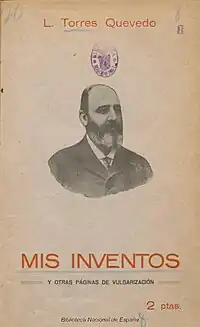
- López-García, Rafael and Ceccarelli, Marco (2023). Distinguished Figures in Mechanical Engineering in Spain and Ibero-America, Springer Nature. pp. 321–357. ISBN 978-3031310751
- Romana García, Manuel; Durán Cermeño, Consuelo; Pascual Nicolás, María (2023). Leonardo Torres Quevedo. Miradas a un inventor célebre. Cinter Divulgación Técnica. ISBN 978-84-125610-3-6.
- Bergreen, Gary (2023). Revolutionary Technologies: Educational Perspectives of Technology History. Rowman & Littlefield. pp. 35–38. ISBN 978-1475870664.
- Kneusel, Ronald T. (2022). Strange Code: Esoteric Languages That Make Programming Fun Again. No Starch Press. pp. 210–216. ISBN 978-1718502406.
- Gomez-Jauregui, Valentin; Gutierrez-Garcia, Andres; González-Redondo, Francisco A.; Iglesias, Miguel; Manchado, Cristina; Otero, Cesar; "Torres Quevedo's mechanical calculator for second-degree equations with complex coefficients", International Federation for the Promotion of Mechanism and Machine Science, Vol. 172, 104830, 2022.
- Pérez Fernández, Rodrigo, and González Redondo, Francisco A. "On the origin, foundational designs and first manufacture of the modern catamaran", International Journal of Maritime History, SAGE Publishing, Vol. 43, Issue 3, 2022.
- Carrasco Martínez, Marcos; Cubas Ortegas, Daniel (2021). Leonardo Torres Quevedo en El Valle de los Inventos. FANES EDITORIAL. ISBN 978-8412399950.
- González de Posada, Francisco, González Redondo, Francisco A., and Hernando González, Alfonso, "Leonardo Torres Quevedo: Pioneer of Computing, Automatics, and Artificial Intelligence", IEEE Ann. Hist. Comp., Vol. 43, No. 3, 2021, pp. 22–43.
- Bruderer, Herbert (2021). Milestones in Analog and Digital Computing. Springer International Publishing. pp. 1206–1212. ISBN 978-3030409739.
- González Redondo, Francisco A., "Exhibition “Leonardo Torres Quevedo: The Universal Engineer”", IEEE Ann. Hist. Comp., Vol. 42, No. 4, 2020, pp. 119-122.
- Garfinkel, Simson L., and Grunspan, Rachel H. (2019). The Computer Book: From the Abacus to Artificial Intelligence, 250 Milestones in the History of Computer Science, Union Square + ORM, pp. 89–91. ISBN 978-1454926221
- Burton, Anthony (2019). Balloons and Airships: A Tale of Lighter Than Air Aviation. Pen and Sword. p. 170. ISBN 978-1526719515.
- de la Fuente Merás, Manuel (2018). Torres Quevedo, inventor del futuro: Un repaso a la construcción del transbordador de las Cataratas del Niágara y otros inventos que marcaron nuestro presente. Independently published. ISBN 978-1729067055.
- Kneusel, Ronald T. (2017). Numbers and Computers, Springer. pp. 84–85. ISBN 978-3319505084
- Everett, H. R. (2015). Unmanned Systems of World Wars I and II. MIT Press. pp. 91–95. ISBN 978-0262029223.
- Carnota, R. J., "The Beginning of Computer Science in Argentina and the Calculus Institute, 1957-1970", IEEE Ann. Hist. Comput., vol. 37, no. 4, pp. 40–52, Oct.–Dec. 2015.
- Dasgupta, Subrata (2014). It Began with Babbage: The Genesis of Computer Science. Oxford University Press. pp. 39–41, 167. ISBN 978-0199309429.
- González Redondo, Francisco A. "The Contribution of Leonardo Torres Quevedo to Lighter-Than-Air Science and Technology", The International Journal for the History of Engineering & Technology, Taylor & Francis, Vol. 81, Issue 2, pp. 40–52, 2011.
- Muller, Jean-Michel; Brisebarre, Nicolas; de Dinechin, Florent; Jeannerod, Claude-Pierre; Lefèvre, Vincent; Melquiond, Guillaume; Revol, Nathalie; Stehlé, Damien; Torres, Serge (2009). Handbook of Floating-Point Arithmetic, Springer Science & Business Media. pp. 4. ISBN 978-0817647056
- Redondo González, Francisco A. (2008). Leonardo Torres Quevedo (Protagonistas de la Aeronáutica). AENA. ISBN 978-1718502406.
- Pérez-Yuste, Antonio, "Early Developments of Wireless Remote Control: The Telekino of Torres-Quevedo", Proceedings of the IEEE, Vol. 96, No. 1, 2008, pp. 186–190.
- Williams, M R., "What does it mean to be the first computer?", Proc. IEEE John Vincent Atanasoff Int. Symp. Modern Comput., pp. 3–9, 2006.
- McCorduck, Pamela (2004). Machines Who Think: A Personal Inquiry into the History and Prospects of Artificial Intelligence. CRC Press. pp. 59–60. ISBN 978-1000065299.
- Dieter Schmoll, H., and Kalchgruber, Markus (2000). Weltseilbahngeschichte, 17. Pendelbahnen im Kommen, Steidl, Eugendorf (near Salzburg). ISBN 3-9501344-0-9
- Lee, John A.N. (1995). International Biographical Dictionary of Computer Pioneers, Taylor & Francis. ISBN 978-1884964473
- Randell, Brian, "The origins of computer programming", Ann. Hist. Comp., Vol. 16, No. 4, 1994, pp. 6–14.
- Jacomy, Bruno (1990). De la machine à calculer de Pascal à l'ordinateur: 350 ans d'informatique, Musée national des techniques, CNAM. ISBN 978-2908207071
- Bromley, Allan G., Difference and analytical engines in Computing Before Computers, Ames, IA, USA:Iowa State Univ. Press, p. 95, 1990.
- Ligonnière, Robert (1987). Préhistoire et histoire des ordinateurs: Des origines du calcul aux premiers calculateurs électroniques. Robert Laffont. ISBN 978-2221052617.
- Randell, Brian (1982). The Origins of Digital Computers: Selected Papers. Springer Science & Business Media. pp. 89–120. ISBN 978-3540113195.
- Randell, Brian, "From Analytical Engine to Electronic Digital Computer: The Contributions of Ludgate, Torres, and Bush", Ann. Hist. Comp., Vol. 4, No. 4, 1982, pp. 327–341.
- Chase, George C., "History of Mechanical Computing Machinery", Ann. Hist.Comp., Vol. 2, No. 3, 1980, pp. 198–226.
- García Santesmases, José (1980). Obra e Inventos de Torres Quevedo. INSTº ESPAÑA. ISBN 978-8485559077.
- Rodriguez Alcalde, L., Biografia de D. Leonardo Torres Quevedo, Institucion Cultural de Cantabria, Consejo Superior de Investigaciones Cientificas, Duputacion Provincial de Santander, Madrid, 1974. ISBN 8-4000-4019-8
- Eames, Charles and Ray (1973). A Computer Perspective. Harvard University Press. pp. 66–68. ISBN 978-0674156258.
- Rodriguez Alcalde, L. (1966). Leonardo Torres Quevedo y la Cibernetica, Publisher Cid., Madrid.
- d'Ocagne, Maurice (1930). Hommes et choses de science: Propos familiers, Librairie Vuibert, Paris, pp. 28–35.
- Whale, George (1919). British Airships, Past, Present & Future. John Lane.
- Torres Quevedo, L. (1917). Mis inventos y otras páginas de vulgarización. Editorial Hesperia.
- Ambrose Talbot, Frederick Arthur (1915). Aeroplanes and Dirigibles of War. Library of Alexandria. ISBN 978-1465504685.
- Jacob, L. (1911). Le calcul mécanique in Appareils Arithmétiques et Algébriques. Intégrateurs. Forgotten Books. pp. 165–187. ISBN 978-0365675815.
Significant Publications
- Torres y Quevedo, "Arithmometre Electromechanique," Bull. de la Societe d Encouragement for l'Industrie Nationale, Vol. 119, 1920, pp. 588–99, reprinted in Randell, Brian, Origins of Digital Computers: Selected Papers, Springer-Verlag, Berlin, 1982.
External links
- From Analytical Engine to Electronic Digital Computer: The Contributions of Ludgate, Torres and Bush
- A Short Account on Leonardo Torres’ Endless Spindle
- Leonardo Torres y Quevedo - Computer Pioneers by J.A.N. Lee. IEEE Computer Society.
- Leonardo Torres y Quevedo – Biography, History and Inventions. History Computer.
- The Complete History of Leonardo Torres’s Chess Machine — Everything You Need To Know. History Computer.
- Leonardo Torres’s Calculating Machine Explained: Everything You Need to Know. History Computer.
- Cybernetics, Computer Design, and a Meeting of the Minds An influential 1951 conference in Paris considered the computer as a model of—and for—the human mind. IEEE Spectrum.
- This 1920 Chess Automaton Was Wired to Win. Inventor Leonardo Torres Quevedo aspired to build machines that think. IEEE Spectrum.
- 1902 – Telekine (Telekino) – Leonardo Torres Quevedo. Cyberneticzoo.com. A history of cybernetic animals and early robots.
- 1911-20 – Chess Playing Machines – Leonardo Torres y Quevedo. Cyberneticzoo.com. A history of cybernetic animals and early robots.
- The Oldest AI. Data Science Central.
- AI Began in 1912. Communications of the ACM.
- Leonardo Torres Quevedo, a Brilliant but Forgotten Spanish Inventor. Communications of the ACM.
- Leonardo Torres. Computer Timeline.
- Leonardo Torres Quevedo. Hispanic Society Museum.
- IEEE: Early Developments in Remote-Control, 1901. Engineering and Technology History Wiki.
- www.TorresQuevedo.org
- Fundación Leonardo Torres Quevedo. University of Cantabria.
- Centro de Interpretación Leonardo Torres Quevedo. Alto Besaya (Cantabria).
- Museo Torres Quevedo. Google Arts & Culture.
- 160th birthday of Leonardo Torres Quevedo. Doodles Archive.
- Fridaygram: early chess computer, Angkor Wat mystery, Art Project expansion. Google for Developers.